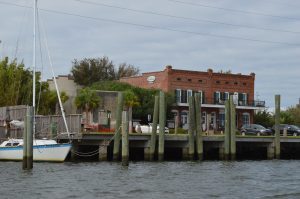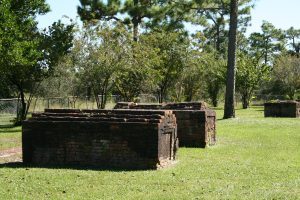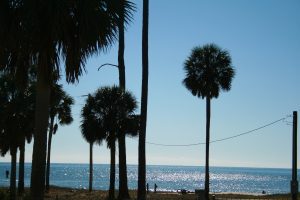Pirates of Cape San Blas, Florida

The Revenue Service, predecessor of today’s U.S. Coast Guard, then had two revenue cutters at St. Marks. These vessels were operating in conjunction with the U.S. Army to suppress trading with the Creek and Seminole warriors who were fighting against the United States in the Panhandle and Big Bend regions of Florida. The Second Seminole War was in its third year and the military was no closer to finding and capturing these Native American parties than it had been when the war started.
The two cutters set out from St. Marks to find the pirates, their crews reinforced by detachments of U.S. soldiers from the military post there. The vessels turned west through St. George Sound and it was not long before they spotted some of the pirates. The officers had donned civilian dress to hide their identities and were able to convince two of the pirates to come aboard:
…The day was calm, and feeling sure of the pirates, all hands went down to dinner, leaving two negro men on deck with them, who it is supposed gave the pirates information of the pursuit and enabled them to escape. When the officers came on deck they found our boat and her crew of murderers at least two miles to windward of them, making for the shore, and a light wind had sprung up which prevented the schooner from giving chase to them. – (Letter from Capt. John Barney, March 6, 1839).
Waterfront of Apalachicola, where the pirates stopped on their way to Cape San Blas.

…We have since then received information that they joined another set of pirates off Cape San Blas, who had also mutinied on board a brig at St. Josephs, killed the second mate, stole the boat and went on board and took possession of a fast sailing sloop, after driving the people belonging to her on shore, and ran away with her. At Cape San Blas they fell in with our beauties, who immediately joined them, and they have no doubt determined to carry on the trade of piracy to its fullest extent, as they were well armed. They were attacked by a pursuit whom they beat off. – (Letter from Capt. John Barney, March 6, 1839).
The Revenue cutters sailed west for Cape San Blas looking for the pirates and the fast sloop taken in the second bloody attack at St. Joseph. This historic seaport once stood on the site of today’s Port St. Joe, Florida. It is unknown whether the pirates coordinated the attacks off St. Marks and in St. Joseph Bay.
The historic cemetery is virtually all that remains of the famed “Lost City” of St. Joseph, Florida. The two men killed nearby by the pirates may have been buried here.

…Two cutters were in search of them, together with the government and civil officers of the territory.
The cutters, it is supposed, drove them in near to St. Josephs, where they were attacked and all of them made prisoners by four constables and a posse of citizens. The place where they were captured was a low marshy spot, and a heavy growth of wood, on the wrong side of a creek to the nearest place where they could be taken and kept with safety, and the party were obliged to cross the creek, in order to keep clear of the Indians who are prowling about in all directions. – (Letter from Capt. John Barney, March 9, 1839).
The ongoing Seminole war also interfered with communications between St. Joseph and St. Marks. Barney reported that couriers of mails, newspapers and other intelligence had a very difficult time getting through due to the presence of warriors throughout the region.
Trapped up the unnamed creek, two of the officers took one of the pirates, a man named Joe Stirk, to look for a boat to be used to ferry the entire party across. Stirk used this as an opportunity to gain the trust of the officers so he could attempt a daring escape:
Cape San Blas has been a landmark to sailors of the Florida coast for hundreds of years.

The captured pirates having gained their freedom took a fast schooner somewhere near the mouth of St. Joseph Bay. They sailed it around to rejoin the sloop off Cape San Blas and both vessels soon set off on a “piratical cruise.”
The pirates had carried out at least three bloody attacks on the coast between St. Marks and St. Joseph. Several men had been killed and others were left badly wounded. They also had possession of two fast vessels, cash, goods, supplies and other booty. The open water of the Gulf of Mexico was before them.
Captain Wilson and his first mate, however, had not seen the last of the pirates. Their next meeting would be one of the strangest chances of fate in the history of piracy.
Original Posted on ExploreSouthernHistory.com
